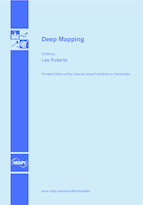Deep Mapping
A special issue of Humanities (ISSN 2076-0787).
Deadline for manuscript submissions: closed (1 June 2015) | Viewed by 123928
Special Issue Editor
Interests: spatial anthropology; urban cultural studies; memory-work and everyday cultures; liminality, space and travel; culture and everyday life
Special Issues, Collections and Topics in MDPI journals
Special Issue Information
Dear Colleagues,
This is a proposal for a Special Issue of the journal, Humanities, on the theme of “deep mapping”. For some time, there has been much discussion of the impacts of a “spatial turn” in arts and humanities disciplines. The more far-reaching these impacts have become, the broader the scope of what a more “spatially inflected” humanities might, and indeed does, look like. Yet, while the breadth of scholarship to which we can attach the provisional label “spatial humanities” has, not surprisingly, foregrounded issues of space and place, questions of time and temporality equally underpin theoretical and practical interventions that are advancing research in this area. The idea of “deep mapping”, which, as a term, has its origins in the writings of William Least Heat-Moon (but as an idea, “deep mapping” has a much deeper provenance), is one that finds resonance across spatial humanities research more generally. While not necessarily couched in such terms, deep mapping speaks to a rich profusion of perspectives that are, in some shape or form, engaged with the mapping or tapping of a layered and multifaceted sense of place, narrative, history, and memory. From Historical GIS, to developments in literary or cinematic geography, or work on popular music heritage and the characterization of place, to approaches that fall under a more generic banner of “psychogeography”, deep mapping encompasses a loose set of orientations and practices that give fuller expression to what we have come to understand as “spatial humanities”. Contributions for this Special Issue are therefore sought from a wide range of fields that address questions that engage with or respond to a conceptual focus on “deep mapping”. Papers that more specifically explore themes of cultural memory in relation to deep mapping or spatial humanities research are particularly welcomed.
Dr. Les Roberts
Guest Editor
Manuscript Submission Information
Manuscripts should be submitted online at www.mdpi.com by registering and logging in to this website. Once you are registered, click here to go to the submission form. Manuscripts can be submitted until the deadline. All papers will be peer-reviewed. Accepted papers will be published continuously in the journal (as soon as accepted) and will be listed together on the special issue website. Research articles, review articles as well as short communications are invited. For planned papers, a title and short abstract (about 100 words) can be sent to the Editorial Office for announcement on this website.
Submitted manuscripts should not have been published previously, nor be under consideration for publication elsewhere (except conference proceedings papers). All manuscripts are thoroughly refereed through a double-blind peer-review process. A guide for authors and other relevant information for submission of manuscripts is available on the Instructions for Authors page. Humanities is an international peer-reviewed open access semimonthly journal published by MDPI.
Please visit the Instructions for Authors page before submitting a manuscript. Submitted papers should be well formatted and use good English. Authors may use MDPI's English editing service prior to publication or during author revisions.
References:
Bodenhamer DJ, Corrigan J, and Harris TM (eds) (2010) The Spatial Humanities: GIS and the Future of Humanities Scholarship. Bloomington: Indiana University Press.
Bodenhamer DJ, Corrigan J, and Harris TM (eds) (2015) Deep Maps and Spatial Narratives. Bloomington: Indiana University Press.
Cooper D, Donaldson C, and Murrieta-Flores P (eds) (2015) Literary Mapping in the Digital Age. London: Ashgate.
Gregory I and Geddes A (eds) (2014) Towards Spatial Humanities: Historical GIS and Spatial History. Bloomington: Indiana University Press.
Hallam J and Roberts L (eds) (2014) Locating the Moving Image: New Approaches to Film and Place. Bloomington: Indiana University Press.
Roberts, L (ed) (2012) Mapping Cultures: Place, Practice, Performance. Basingstoke: Palgrave.
Tally Jr, RT (2012) Spatiality. London: Routledge
Warf B and Arias S (eds) (2008) The Spatial Turn: Interdisciplinary Perspectives. London: Routledge.
Keywords
- spatial humanities
- spatial anthropology
- deep mapping
- cinematic geography/cartography
- literary geography/cartography
- historical GIS
- digital cultural mapping
- psychogeography
- spatial turn






